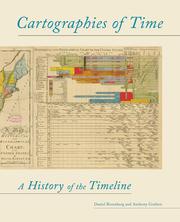| Listing 1 - 3 of 3 |
Sort by
|
Book
ISBN: 9789057595714 9057595710 9789460581120 9460581129 Year: 2013 Publisher: Antwerpen Amsterdam Luster Podium
Abstract | Keywords | Export | Availability | Bookmark
 Loading...
Loading...Choose an application
- Reference Manager
- EndNote
- RefWorks (Direct export to RefWorks)
Geschiedenis van de cartografie.
Geodesy. Cartography --- Geographers. Cartographers --- Cartography --- History --- Cartes --- Miscellanea --- World maps --- aardrijkskunde --- geografie --- cartografie --- cultuurgeschiedenis --- cultuurfilosofie --- 130.2 --- 528 --- PXL-Media & Tourism 2019 --- wereldatlas --- wereldgeschiedenis --- landkaarten --- Cartografie --- Kaarten --- Geschiedenis --- grafisch design --- grafische vormgeving --- informatiedesign --- information design --- 766.022 --- Kaart (geografie) --- Geneeskunde --- Techniek (wetenschap) --- Atlas --- Museum

ISBN: 9781568987637 9781616890582 1568987633 Year: 2010 Publisher: New York Princeton architectural press
Abstract | Keywords | Export | Availability | Bookmark
 Loading...
Loading...Choose an application
- Reference Manager
- EndNote
- RefWorks (Direct export to RefWorks)
"From the most ancient images to the contemporary, the line serves as a central figure in the representation of time. The linear metaphor is ubiquitous in visual representations of time - in almanacs, calendars, charts, and graphs of all sorts. Even our everyday speech is filled with talk of time having a "before" and an "after" or being "long" and "short." The timeline is such a familiar part of our mental furniture that it is sometimes hard to remember that we ever acquired it in the first place. And yet, in its modern form, the timeline is not even 250 years old. The story of what came before has until now never been fully told." "Cartographies of Time is the first comprehensive history of graphic representations of time in Europe and the United States from 1450 to the present. Authors Daniel Rosenberg and Anthony Grafton have crafted a lively history featuring fanciful characters and unexpected twists and turns. From medieval manuscripts to websites, Cartographies of Time features a wide variety of timelines that in their own unique ways - curving, crossing, branching - defy conventional thinking about the form. A fifty-four-foot-long timeline from 1753 is mounted on a scroll and encased in a protective box, while another timeline uses the different parts of the human body to show the genealogies of Jesus Christ and the rulers of Saxony. Ladders created by Catholic and Protestant missionaries illustrate Bible stories in a vertical format to encourage American Indians in Oregon to convert. Also included is the April 1912 Marconi North Atlantic Communication chart, which tracked ships, including the Titanic, at points in time rather than by their geographic location. There are even little-known works by famous figures, including a historical chronology by the mapmaker Gerardus Mercator and a chronological board game patented by Mark Twain. This lavishly illustrated edition is a revelation to anyone interested in the role visual forms have played incur evolving conception of history."--BOOK JACKET.
Book history --- History as a science --- Geodesy. Cartography --- Chronology, Historical. --- Chronology, Historical --- History --- Chronologie historique --- Histoire --- Maps. --- Philosophy. --- Atlas --- Philosophie --- grafische vormgeving --- grafisch design --- informatiedesign --- tijd --- tijdlijnen --- kunst --- 766.022 --- 006.9 --- 766 --- 93/94 --- 912 <09> --- 930.11 --- Tijd --- Chronologie --- Grafische vormgeving --- Geschiedenis --- Cartografie. Kaarten. Plattegronden. Atlassen--Geschiedenis van ... --- Filosofie van de geschiedenis. Geschiedenisfilosofie --- 930.11 Filosofie van de geschiedenis. Geschiedenisfilosofie --- History, Modern --- Annals --- Dates (Chronology) --- Historical chronology --- World history --- Philosophy --- Cartografie. Kaarten. Plattegronden. Atlassen--Geschiedenis van .. --- Cartografie. Kaarten. Plattegronden. Atlassen--Geschiedenis van . --- PXL-Music 2017 --- geschiedenis --- kaarten --- dataverzameling --- visualiseren --- Cartografie. Kaarten. Plattegronden. Atlassen--Geschiedenis van
Book
ISBN: 9789033468889 Year: 2008 Volume: 4 Publisher: Leuven Acco
Abstract | Keywords | Export | Availability | Bookmark
 Loading...
Loading...Choose an application
- Reference Manager
- EndNote
- RefWorks (Direct export to RefWorks)
cartography [discipline] --- massacommunicatie --- onderzoek in de kunsten --- Organization theory --- Geodesy. Cartography --- research [function] --- cartografie --- Mass communications --- Cartes dans l'art --- Cartografie in de kunst --- Cartographie dans l'art --- Cartography in art --- Kaarten in de kunst --- Maps in art --- 373.67 --- IvOK (Instituut voor Onderzoek in de Kunsten) --- 592 --- 7.073 --- 7.01 --- IvOK ; Instituut voor Onderzoek in de Kunsten --- Onderzoek in de kunsten --- Kunsttheorie ; over cartografische informatie ; mapping --- Artistiek onderzoek --- Asselberghs, Herman --- kunst --- IvOK --- kunsttheorie --- film --- Maeda John --- Wozencroft Jon --- Pope Simon --- 7 --- Academic collection --- Onderzoek (kunst) --- Publicaties onderzoeksinstellingen --- Kunst ; onderzoek in de kunsten, ontwerpproblemen --- Kunst ; theorie, filosofie, esthetica --- MAD-faculty 14 --- hedendaagse kunst --- 373.67.04 --- Onderwijs ; kunst- architectuuronderwijs ; onderzoek in de kunsten ; architectuuronderzoek ; doctoraatsonderzoek --- mass media
| Listing 1 - 3 of 3 |
Sort by
|

 Search
Search Feedback
Feedback About
About Help
Help News
News